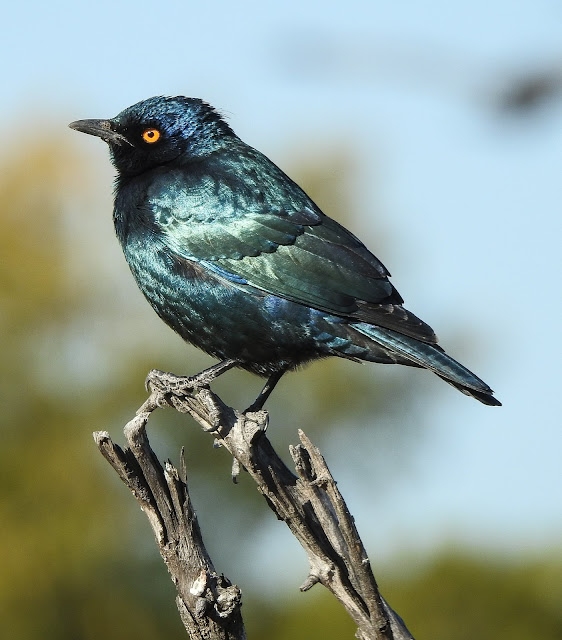The greater blue-eared starling, or Lamprotornis chalybaeus, is a striking bird adorned in glossy blue-green plumage with a purple-blue belly and a distinctive blue ear patch. This bird measures approximately 22 cm in length and sports a short tail. The iris of this species is a vivid yellow or orange, adding to its captivating appearance. Both sexes exhibit similar coloration, though juveniles can be distinguished by their duller feathers and blackish-brown underparts.
When identifying the greater blue-eared starling, look for its glossy blue-green upperparts and purple-blue belly. The blue ear patch is a key feature, along with its bright yellow or orange iris. Juveniles are less lustrous and have darker underparts. This species can be confused with the lesser blue-eared starling, but the latter's blue belly does not extend forward of the legs.
The greater blue-eared starling is commonly found in open woodland environments, where it thrives and breeds.
This bird has a broad range across the African continent, from Senegal in the west, stretching east to Ethiopia, and then southward through eastern Africa to northeastern South Africa and Angola. It is known to undertake seasonal migrations within this range.
The greater blue-eared starling is a highly social bird, often seen in large flocks that may include other starling species. It is also known to roost communally in reedbeds, thorn bushes, or acacia trees, sometimes sharing these spaces with other birds.

The vocal repertoire of the greater blue-eared starling includes a variety of musical and grating calls. A commonly heard call is a nasal "squee-ar," which is quite distinctive.
Breeding pairs of greater blue-eared starlings make their nests in tree holes, which can be naturally occurring or previously excavated by woodpeckers or barbets. They are also known to utilize the large stick nests of the sacred ibis or Abdim's stork. Their nests typically contain three to five greenish-blue eggs adorned with brown or purple spots. These eggs hatch after about 13–14 days, and the fledglings leave the nest approximately 23 days post-hatching. The species is occasionally parasitized by the great spotted cuckoo and, less frequently, by the greater honeyguide.

An omnivorous bird, the greater blue-eared starling's diet is predominantly insectivorous, foraging mainly on the ground for a variety of invertebrates. It also consumes seeds and berries, with a particular fondness for figs. Additionally, these starlings are known to perch on livestock, picking off insects disturbed by the animals and sometimes removing ectoparasites.
The IUCN Red List classifies the greater blue-eared starling as Least Concern, indicating that the species does not currently face any significant threats to its survival.

A medium-sized iridescent blue-green glossy starling with a dark ear-patch and contrasting royal blue to violet flanks and belly. Pairs and small groups occupy savanna, where they feed on the ground and in trees on fruit and insects; occasionally up to 300 may gather at fruiting trees. Often the species scavenges from people. It gives a cat-like nasal “squuee-aar” contact call that is distinctive.
The similar Lesser Blue-eared Starling differs from Greater Blue-eared Starling by being smaller with a more compact head and finer bill, by having a smaller ear-patch, and by preferring broadleaf woodland. The Cape Starling differs from the “blue-eared” starlings by having greener ear-patches, belly, and flanks.









%2020.jpg)


%20PHOTO%20COURTESY%20OF%20MRS%20VALERIE%20FISHER%2020.jpg)
%20PHOTO%20COURTESY%20OF%20MRS%20VALERIE%20FISHER%2021.jpg)





%2019.jpg)
%2020.jpg)
%2021.jpg)













%20%20%20COURTESY%20VALERIE%20FISHER%2020.jpg)


%20%20%20COURTESY%20VALERIE%20FISHER%2021.jpg)


%2012.jpg)
%2011.jpg)
